Dive Brief:
- Cisco rolled out a series of hardware upgrades designed to ease enterprise AI adoption, including retooled networking components, a unified network management platform and the Deep Network Model domain-specific large language model to power an AI assistant, the company said Tuesday at its annual Cisco Live conference in San Diego.
- “As AI transforms work, it fuels explosive traffic growth across campus, branch and industrial networks, overwhelming IT teams with complexity and novel security risks at a time when downtime has never been more costly,” Jeetu Patel, president and chief product officer at Cisco, said in the announcement.
- Cisco’s portfolio overhaul comes as CIOs grapple with infrastructure limitations and safety concerns inherent in AI deployments, according to Matt Eastwood, IDC SVP of enterprise infrastructure. “The reality is that existing enterprise networks are simply not equipped to handle the scale, security and reliability requirements that AI demands,” Eastwood said in the announcement.
Dive Insight:
Cisco is banking on enterprises taking a hybrid route to AI adoption. The LLMs that power off-the-shelf chatbots, copilots and AI assistants are trained on high-capacity chips in massive cloud data centers but enterprises need secure networks to connect models to their data.
The company signaled an enterprise IT shift last month, after surpassing its fiscal year 2025 goal of $1 billion in hyperscaler AI networking gear orders in its third quarter, which ended on April 26.
“On the tail-end of building out all the public cloud infrastructure for training, there is a significantly larger opportunity in enterprise AI, as they build out the capability to do inferencing inside their own data centers,” Cisco EVP and CFO Scott Herren said during the Q3 2025 earnings call.
Cisco saw revenue increase 11% to $14.1 billion, with networking revenue growing 8% year over year. Switches and enterprise routing equipment led the segment with double-digit growth, Herren said.
As AI infrastructure build outs reach into the enterprise, Cisco has tightened its alliance with GPU chipmaker Nvidia. The two companies agreed to collaborate on an integrated architecture for AI-ready enterprise data center networks in February and announced Tuesday that Nvidia’s RTX Pro 6000 Blackwell Server Edition GPU is available in Cisco servers.
In addition to training a network-savvy AI agent trained on Cisco specifications and courseware to detect anomalies, diagnose problems and automate workflows, the company is designing routers, switches and other networking gear for a growing class of agentic tools, Patel said during a briefing last week.
“There'll be tens of billions of agents conducting work on our behalf,” said Patel. “To get all this to happen, the fundamental requirements around infrastructure, as well as safety and security, will need to be completely rethought, because the classical ways that infrastructure was handled just won't be able to deal with the scale and proportion that we're talking about — that's why you're seeing such a massive level of build out globally of data center capacity.”
The largest hyperscaler by market share, AWS, committed $20 billion to AI infrastructure buildouts in Pennsylvania on Monday. The company announced plans for a $10 billion data center construction project in North Carolina last week.
Enterprises are eager to shore up on-site infrastructure, too. Nearly 9 in 10 organizations plan to expand compute capacity to run AI workloads, according to a Sandpiper Research and Insights survey of more than 8,000 senior IT and business leaders commissioned by Cisco. More than three-quarters of respondents said their organization had suffered a major network outage due to congestion, cyberattack or misconfiguration.
“The consequence of us not getting this infrastructure piece right is pretty profound,” Patel said. “What we want to do is have people not have to think about infrastructure.”















